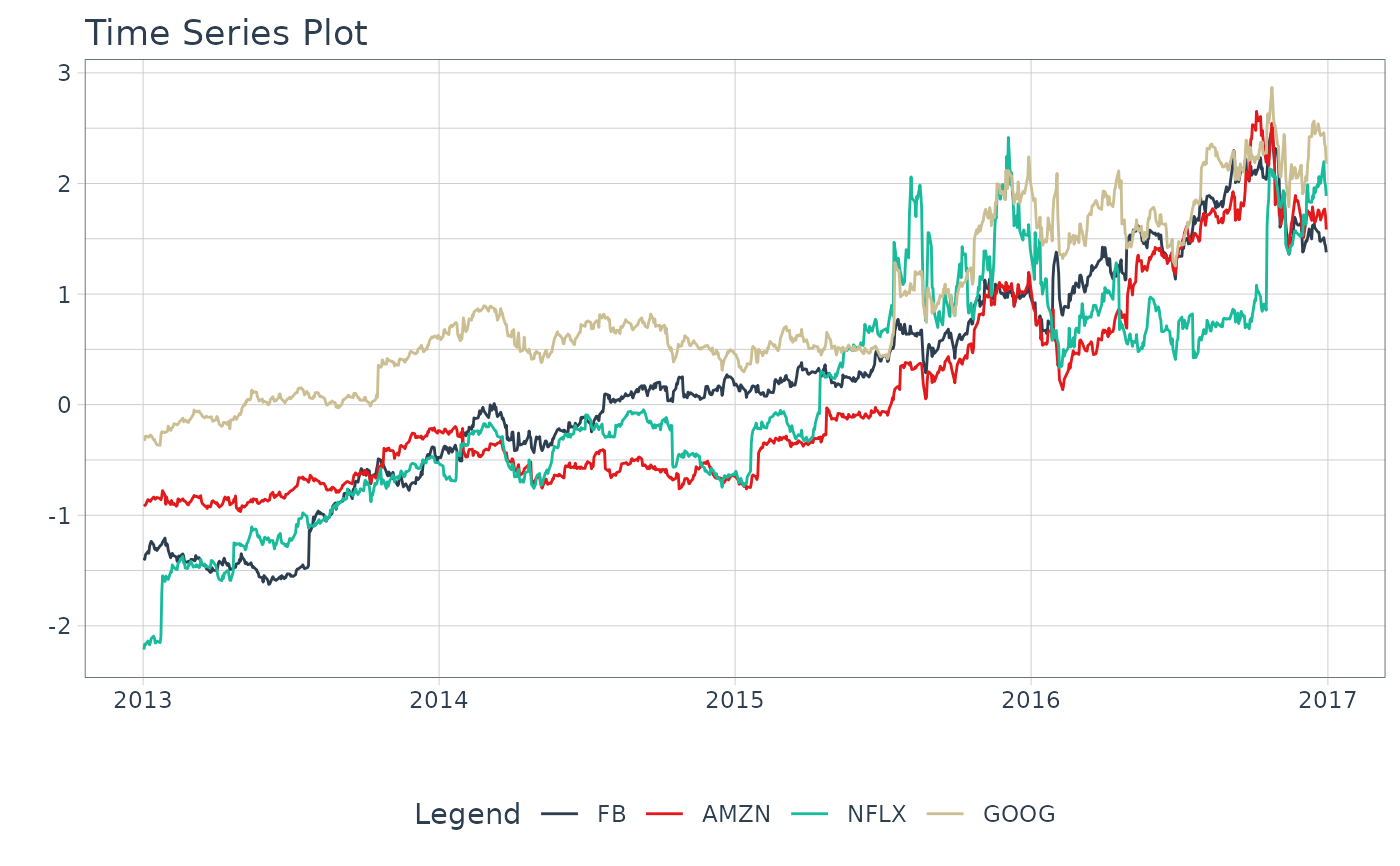
Log Interval Transformation for Constrained Interval Forecasting
Source:R/recipes-step_log_interval.R
step_log_interval.Rdstep_log_interval creates a specification of a recipe
step that will transform data using a Log-Inerval
transformation. This function provides a recipes interface
for the log_interval_vec() transformation function.
Arguments
- recipe
A
recipeobject. The step will be added to the sequence of operations for this recipe.- ...
One or more selector functions to choose which variables are affected by the step. See
recipes::selections()for more details. For thetidymethod, these are not currently used.- limit_lower
A lower limit. Must be less than the minimum value. If set to "auto", selects zero.
- limit_upper
An upper limit. Must be greater than the maximum value. If set to "auto", selects a value that is 10% greater than the maximum value.
- offset
An offset to include in the log transformation. Useful when the data contains values less than or equal to zero.
- role
Not used by this step since no new variables are created.
- trained
A logical to indicate if the quantities for preprocessing have been estimated.
- limit_lower_trained
A numeric vector of transformation values. This is
NULLuntil computed byprep().- limit_upper_trained
A numeric vector of transformation values. This is
NULLuntil computed byprep().- skip
A logical. Should the step be skipped when the recipe is baked by
bake.recipe()? While all operations are baked whenprep.recipe()is run, some operations may not be able to be conducted on new data (e.g. processing the outcome variable(s)). Care should be taken when usingskip = TRUEas it may affect the computations for subsequent operations.- id
A character string that is unique to this step to identify it.
- x
A
step_log_intervalobject.
Value
An updated version of recipe with the new step
added to the sequence of existing steps (if any). For the
tidy method, a tibble with columns terms (the
selectors or variables selected) and value (the
lambda estimate).
Details
The step_log_interval() function is designed specifically to handle time series
using methods implemented in the Forecast R Package.
Positive Data
If data includes values of zero, use offset to adjust the series to make the values positive.
Implementation
Refer to the log_interval_vec() function for the transformation implementation details.
See also
Time Series Analysis:
Engineered Features:
step_timeseries_signature(),step_holiday_signature(),step_fourier()Diffs & Lags
step_diff(),recipes::step_lag()Smoothing:
step_slidify(),step_smooth()Variance Reduction:
step_log_interval()Imputation:
step_ts_impute(),step_ts_clean()Padding:
step_ts_pad()
Transformations to reduce variance:
recipes::step_log()- Log transformationrecipes::step_sqrt()- Square-Root Power Transformation
Recipe Setup and Application:
Examples
library(dplyr)
library(recipes)
FANG_wide <- FANG %>%
select(symbol, date, adjusted) %>%
tidyr::pivot_wider(names_from = symbol, values_from = adjusted)
recipe_log_interval <- recipe(~ ., data = FANG_wide) %>%
step_log_interval(FB, AMZN, NFLX, GOOG, offset = 1) %>%
prep()
#> $FB
#> [1] 0
#>
#> $FB
#> [1] 145.318
#>
#> $AMZN
#> [1] 0
#>
#> $AMZN
#> [1] 904.973
#>
#> $NFLX
#> [1] 0
#>
#> $NFLX
#> [1] 143.7086
#>
#> $GOOG
#> [1] 0
#>
#> $GOOG
#> [1] 860.3125
#>
recipe_log_interval %>%
bake(FANG_wide) %>%
tidyr::pivot_longer(-date) %>%
plot_time_series(date, value, name, .smooth = FALSE, .interactive = FALSE)
#> $FB
#> [1] 0
#>
#> $FB
#> [1] 145.318
#>
#> $AMZN
#> [1] 0
#>
#> $AMZN
#> [1] 904.973
#>
#> $NFLX
#> [1] 0
#>
#> $NFLX
#> [1] 143.7086
#>
#> $GOOG
#> [1] 0
#>
#> $GOOG
#> [1] 860.3125
#>
 recipe_log_interval %>% tidy(1)
#> # A tibble: 4 × 5
#> terms limit_lower limit_upper offset id
#> <chr> <dbl> <dbl> <dbl> <chr>
#> 1 FB 0 145. 1 log_interval_71neM
#> 2 AMZN 0 905. 1 log_interval_71neM
#> 3 NFLX 0 144. 1 log_interval_71neM
#> 4 GOOG 0 860. 1 log_interval_71neM
recipe_log_interval %>% tidy(1)
#> # A tibble: 4 × 5
#> terms limit_lower limit_upper offset id
#> <chr> <dbl> <dbl> <dbl> <chr>
#> 1 FB 0 145. 1 log_interval_71neM
#> 2 AMZN 0 905. 1 log_interval_71neM
#> 3 NFLX 0 144. 1 log_interval_71neM
#> 4 GOOG 0 860. 1 log_interval_71neM